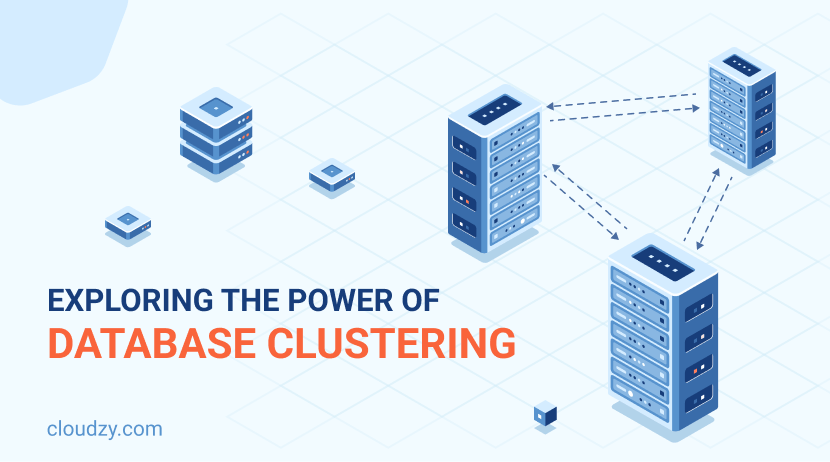Imagine a scenario in which your server struggles to handle the large volume of data that it’s storing. Or a similar scenario in which your server receives too many requests from users or applications. These situations can cause performance issues and lead to slower response times. But there’s a highly efficient solution to this problem. If a group of servers work together as a single system to manage the database, the extra workload will be distributed across all of them. The result of this clustering system is more efficiency and better performance.
If you’re interested in learning more about the advantages of database clustering and its different types, follow along to the end of this blog post where we introduce database clustering in simple terms.

What Are the Advantages of Database Clustering?
When it comes to server performance there are a lot of underlying factors that contribute to it. And as a business owner or application developer, of course you want to take control of these factors to maximize your server’s performance. Database clustering can improve the overall server performance by providing high availability, load balancing, and scalability. So, let’s review all of the advantageous features of database clustering one by one.
High Availability
One of the most important advantages of database clustering is high availability. Even if one server crashes down and becomes unavailable for a while, other servers stay up and running. This way the users won’t even notice the server failure issue. By automatically transferring the workload to other nodes in the cluster, downtime decreases and applications continue to operate.
Load Balancing
Another important benefit of database clustering is avoiding bottlenecks through load balancing. Database clusters can distribute the workload evenly across all nodes. This way no single server is doomed to bear heavy pressure and bottlenecks won’t happen. As a result, users will be more satisfied because they experience faster response times and applications run more smoothly.
Scalability
Scalability is another significant advantage of database clustering. If your business expands in size and data volume or the number of user requests increases, database clusters can be scaled to meet the new demand. You can add more nodes to the database cluster to enhance its capacity and processing power. This way, your business can easily scale up and remain fully responsible.
Data Redundancy and Backup
Database clusters can provide data redundancy and backup. Imagine that a node fails. What would happen to your data? Well, thanks to database clustering, nothing major would happen. Through database clustering, data is replicated through multiple nodes. This way even if one node breaks down, you can always have an available copy of your data. This process is like an automatic back up that doesn’t require much effort.
Disaster Recovery
The same feature of database clustering that makes data redundancy and backup possible, can also provide disaster recovery. The distributed architecture of a database cluster allows it to withstand both local failures and also more significant disasters that can impact an entire data center. Imagine that one part of the cluster is affected by a catastrophic event. The workload that this cluster was carrying will now be routed to other clusters in another location.

Types of Database Clusters
We can categorize database clusters based on the architecture of a database cluster and how it stores and manages data. If you want to choose the right clustering approach, understanding these types is important. Here are the primary types of database clusters:
Shared-Nothing Clusters
Shared-nothing clusters are designed in a way that every node in the cluster is independent and has its own private resources like CPU, memory, and disk storage. Each node managing a subset of the data and this way data is partitioned across the cluster. This specific architecture reduces the risk of a single point of failure because each node operates independently.
Shared-Disk Clusters
In a shared disk cluster, all nodes in the cluster have access to the same disk storage but manage their own private cache and processing. In this type, any node can have access to any data block on the shared storage. Shared-disk clustering can be useful for you if you need data to be available across all nodes without the need for data partitioning. If you want to know more about different types of server storage, we encourage you to read our blog on HDD vs SSD Server.
Shared-Everything Clusters
Shared-everything clusters, also known as symmetric multiprocessing systems. These clusters allow multiple processors to operate on the same data in memory. These clusters can distribute tasks among different processors. This feature makes them suitable for environments that require high performance.
Replication Clusters
This type of database cluster is great for enhancing availability and resilience in a database environment. In a replication cluster, data is copied and synchronized from a primary database to one or more secondary databases. And whenever you change the primary database, those changes will be applied to the secondary database. This replicating system makes sure that all nodes of data are up-to-date with all recent changes.
Load-Balanced Clusters
Load-balanced clusters are designed to efficiently distribute workloads across multiple database servers. This type of cluster has a load balancer that directs database queries to the least busy server. This way resources are used in the most efficient way possible and no single database server is overloaded with requests. You could say this database cluster is like a smart traffic system that routes data requests to the most efficient path. If your environment experiences fluctuating or high volumes of data queries, you can benefit a lot from this type of database cluster. If you’re curious to learn more the advantages of this type of clusters, you can read our blog on the benefits of load balancing for enterprises.
You can choose the right database clustering method based on the specific needs of your system. In order to make an efficient decision, make sure to educate yourself on this issue and properly consider your specific requirements.
Want a high-performance Cloud VPS? Get yours today and only pay for what you use with Cloudzy!![]() Cloud VPS
Cloud VPS
Conclusion
In this blog post, we talked about “what is database clustering?”, its advantages, and the different types of a database cluster. By familiarizing yourself with these concepts, you can make an informed decision and benefit from all the useful features of database clustering.
Also if you’re looking for a high-performing VPS that can fulfill all of your demands, consider Cloudzy’s cloud server as a reliable option. Here, at Cloudzy, we offer a 99.95% uptime guarantee, 24/7 technical support, and a pre-installed OS of your choice. Get your Cloud VPS today and change your server experience with high performance and exceptional availability.
FAQ
What is database clustering?
Database clustering is the process of linking multiple servers or databases together to operate as a single system. Database clustering can enhance data availability and performance. It can also increase fault tolerance by distributing workloads and making multiple copies of data.
What is database cluster?
A collection of databases managed by a single database management system (DBMS) is a database cluster. Database clusters work together to improve data availability and performance. Clusters support different architectures like replication and load-balancing, to allow data access and high availability across multiple nodes.
How to create a database cluster?
For creating a database cluster, you need to first choose a suitable clustering method. Then you should install the necessary database software on all nodes and configure the cluster settings. Finally you should initialize the cluster to make sure all nodes are correctly linked and operational.




